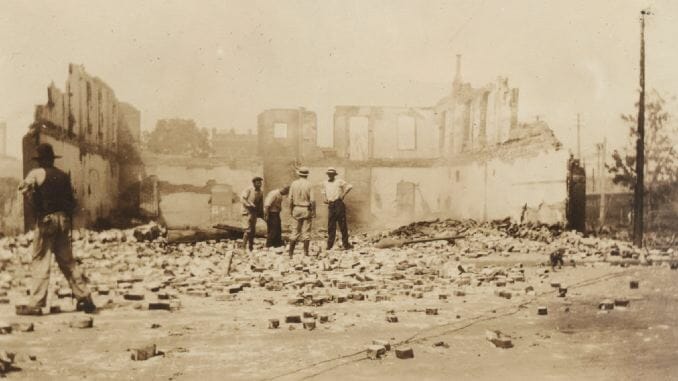Tulsa: The Fire and the Forgotten Tracks the Physical Erasure, Reclamation of History

HBO’s Watchmen may have helped raise public awareness of the Tulsa Race Massacre that killed countless Black people and burned the Oklahoma city’s Black Wall Street to the ground, but that only means that we have more learning to do—and not just about Tulsa. New York Times columnist Jamelle Bouie wrote that “the level of reader familiarity with the country’s history of racial pogroms was much lower even 8 or 9 years ago,” and a string of new documentaries are aiding in that ever-increasing historical literacy. Director Jonathan Silver’s Tulsa: The Fire and the Forgotten airs on PBS a hundred years after the racist act of domestic terrorism, tracking the effort not only to understand the event but to canonize its history.
The burning of Black Wall Street—like so many unsavory events, people, causes and motives—was buried by those conservative and white powers that be who set the past in stone. Controlling school textbooks means the proliferation of Lost Cause narratives. “Genocide” was not a term used for what settlers did to Indigenous people. As Rob Alex Fitt puts it, “Malcolm X was included, but only so he could be shown to have been assassinated.” So of course, a distilled microcosm of all that this revisionism wants to hide would suffer the same obscured fate, but without even the dignity of an alternative narrative. “We had to take Oklahoma History and Geography,” one interviewee says of the Massacre. “None of those things were ever mentioned.” I took those same classes, and I didn’t hear about the Massacre until I went to college downstate in Norman. Good luck if you’re out of state.
Composed using The Washington Post’s DeNeen L. Brown’s reports, The Fire and the Forgotten responds to this informational void with context. The Massacre itself is explained—and, I’m sure to some, proven—as the narrative reveals its bevy of archival photographs documenting the grisly aftermath. But it’s not until Brown begins touching on the modern efforts to spotlight the Massacre that the doc grows beyond its newsy trappings.
Oklahoma, and Tulsa in particular, has been oh-so-hesitant to discuss its history of racism. Why bother in a state that’s certainly not trying to change anything anytime soon? Graphic footage of police, acquitted of murdering Terence Crutcher, shooting him down in the street, asks that question well enough. Tulsa was the first city to remove a Black Lives Matter mural after the murder of George Floyd. As armed alt-right militia members show to up to BLM protests, you see the contents of PBS’s American Insurrection from earlier this year bleed over—an inevitability as white supremacy continues to be one of our most predominant cultural forces. But thanks to the efforts of protestors, preachers, historians, activists and archeologists, the government has started the slow process of legitimizing the Massacre’s place in state history.
Silver deploys moving archival interviews from survivors who were spoken to in 1999 when a state commission began researching and documenting the event. Nebulous reparations were its potential endpoint. They never came. But its efforts still kicked off something important, as the film emphasizes the burial, uncovering and rediscovery of this event—and of the country’s history of racial pogroms in general. This national amnesia, convenient and selective, is debunked as the intentional hoax it always was thanks to the memories of these men and women. Following these testimonials, further examples of the historical cover-up underline the institutionalized cruelty that continues to permeate it to this day. A decision by the Tenth Circuit court as they determine that no reparations are due to the descendants of Massacre victims from the state that sanctioned it explains that “there is no comfort or satisfaction in this result.” No kidding. Power continues to suppress and those underneath do their best to avoid being smothered out of existence.
-

-

-

-

-

-

-

-

-

-

-

-

-

-

-

-

-

-

-

-

-

-

-

-

-

-

-

-

-

-

-

-

-

-

-

-

-

-

-

-








































